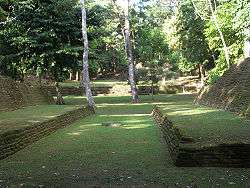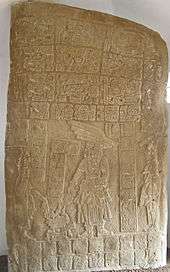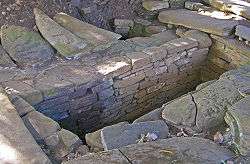Nim Li Punit
Nim Li Punit (/nim li puˈnit/) is a Maya Classic Period site in the Toledo District of the nation of Belize, located 40 kilometres north of the town of Punta Gorda, at 16° 19' N, 88° 47' 60W. Nim Li Punit is sometimes known as Big Hat or Top Hat; the name is Kekchi Maya for "Big Hat", referring to the large elaborate head-dress on a stela sculpture found on site depicting one of the site's ancient kings.
 Ballcourt at Nim Li Punit Mayan ruins. | |
| Location | Belize |
|---|---|
Nim Li Punit is a medium-sized site from the Maya Classic Period, flourishing from the 5th century AD through the 8th century AD. It consists of structures around three plazas, including several step-pyramids, the tallest being 12.2 meters high. The site has a number of carved stelae illustrating the ancient city's rulers. Several stelae are in an unfinished state, suggesting a sudden halt to work. The site is near Belize's Southern Highway and is open to visitors subject to an admission charge.
Geography and geology
 |
| Maya civilization |
|---|
| History |
| Preclassic Maya |
| Classic Maya collapse |
| Spanish conquest of the Maya |
Nim Li Punit is situated in the foothills of the Maya Mountains with proximity to clear mountain streams. The Maya Mountains form a nearly impenetrable backdrop forest to the north and east, while the expansive somewhat swampy coastal lowlands adjoining the Caribbean Sea lie to the east. Low-lying swampland between the Sarstoon and Temash Rivers is situated to the south. The site is within two kilometres of Belize's Southern Highway, accessed by an unpaved road. (The Southern Highway itself is paved in the vicinity of the site as well.) Area soils are relatively fertile for tropical standards, and explain the region's ability to support sizeable prehistoric settlements such as Nim Li Punit. Local sandstones are found in nearby stream and river beds, and these materials were used as the principal building stones for the site's structures and stelae. The Maya Mountains and foothills are among the oldest surface rock formations of Central America ; these Paleozoic sediments were uplifted about 200 million years ago in the late Carboniferous (Pennsylvanian) and Early Permian periods.[1]
Architecture
The ancient city of Nim Li Punit was laid out in a fashion consistent with other Mayan lowland Classic Era sites, such as Lubaantun, Pusilha and Uxbenka; the latter two of these sites are deemed to have arisen earlier than the former two. Nim Li Punit is constructed in the Classic Period prototypical geometric form, using large amounts of fill material to achieve expansive level plazas and terraces;[2] furthermore, the arrangement of the major structures emulates the view of the Mayan cosmological world, setting the earth realm at the core, manifested by a dwelling of the ruler. The sky world is exhibited characteristically in the north by shrines and burial structures. The location of the ballcourt is intermediary, illustrating the position of this activity to represent perpetual conflict between the forces of life and death. The ballcourt is so well preserved, it appears ready to host a game.
It is thought that within the Plaza of the Stela in the South Group that there is an E Group geometry that would have been used for astronomical observations. For example, several monuments present before a long terrace known as Structure One, which mark the location of solstices and equinoxes. Unlike Lubaantun, where dry-stone construction was employed, the stone structures are cemented with Mayan mortar; moreover, the elaborate notched jointing often found in Lubaantun is absent in Nim Li Punit.[3]
Population and occupation

The peak population of Nim Li Punit is estimated to have been in the range of 5000 to 7000 people during the peak occupation Late Classic period.[4] Early occupiers of this site probably migrated from Guatemala, similar to the history of nearby Lubaantun. The peoples of Nim Li Punit are thought to have spoken a dialect of the Cholan language, which is that spoken in the Mayan heartland. Evidence from carved stelae document the site was active in the period 721 to 790 AD, based upon actual Mayan calendar dates inscribed on at least six different stones. As at many other Mayan sites occupation of Nim Li Punit ceased rather suddenly in the 9th century AD, probably associated with areawide overpopulation exceeding the region's carrying capacity of the then prevalent milpa farming system.[5] The Nim Li Punit population is thought to have been aligned with Mayan settlements such as Tikal in the Petén Basin region of Guatemala. The visitors' center indicates that this site had political and social connections with Copan in Honduras.
Ecology

Nim Li Punit is situated in a locale rich in forest, soil, rock and other natural resources. These assets, coupled with proximity to ample flowing mountain streams, provided the aboriginal Maya at Nim Li Punit a resource base that allowed their civilisation to thrive. While most of the surrounding broadleaf tropical rainforest is secondary growth, due to the disturbance of the Maya themselves, there is considerable biodiversity of trees, herbs, mammals, birds, reptiles and other life forms. In addition to the soils being able to support basic prehistoric staple crops of beans and corn, there are diverse herbs in the vicinity known to have been used by the "ancient ones" for medicinal purposes.
Mammals found in the area include two primates: Yucatán black howler monkey, Alouatta pigra and Central American spider monkey, Ateles geoffroya. Numerous rodents are found here including the common paca, Agouti paca. A variety of carnivores are present, such as the cougar Puma concolor and jaguar Panthera onca. Further, hosts of bats and birds frequent the present forest as they did the ancient forest.
Discovery and excavation

Nim Li Punit was discovered in 1976 with initial explorations conducted by Norman Hammond of the British Museum-Cambridge University. Hammond produced the first site map and excavated a portion of the central plaza. Barbara McLeod of the University of Texas, Austin, then produced the first detailed analyses of stelae inscriptions. Richard Levanthal in 1983 bored test pits and surveyed the site as part of an overall southern Belize Mayan mapping project. In the 1990s minor excavations were conducted by the Belize Department of Archaeology under the supervision of John Morris and Juan Luis Bonor. In 2015, tomb excavations were conducted by the Toledo Regional Interaction Project directed by Geoffrey Braswell. This excavation unearthed numerous clay pots and a large jade pendant inscribed with Mayan hieroglyphs.[6][7]
References
- Katherine M. Emmons et al., ‘' Cockscomb Basin Wildlife Sanctuary'‘, Producciones de la Hamaca, Belize and Orang-utan Press, Gays Mills, Wisconsin, USA (1996)
- The ancient Maya of the Belize Valley: half a century of archaeological research, ed. J.F.Garber, Gainesville University Press of Florida (2004)
- C. M.Hogan, Comparison of Mayan sites in southern and western Belize, Lumina Technologies (2006)
- '‘Nim Li Punit'‘, published by the Department of Archaeology, Blmopan, Belize, Project ACP-RPR 544, Cubola Productions, March, 1999
- Jaime Awe, Maya Cities and Sacred Caves, Cubola Books ISBN 976-8161-11-6 (2006)
- "Archaeologists Unearth Tombs at Nim Li Punit". News 5. Belize. 4 June 2015. Retrieved 28 February 2017.
- Prager, Christian M.; Braswell, Geoffrey E. (28 November 2016). "Maya Politics and Ritual: An Important New Hieroglyphic Text on a Carved Jade from Belize". Ancient Mesoamerica. 27 (2): 267–278. doi:10.1017/S095653611600033X. Retrieved 28 February 2017.
External links

